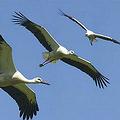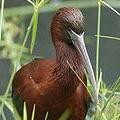 根據15日公佈的全新研究結果,在非洲與歐亞之間往返的遷徙水鳥族群,有4成因為氣候變化與濕地破壞而減少。研究發表於塔那那利佛召開的國際性遷徙水鳥保育會議。
根據15日公佈的全新研究結果,在非洲與歐亞之間往返的遷徙水鳥族群,有4成因為氣候變化與濕地破壞而減少。研究發表於塔那那利佛召開的國際性遷徙水鳥保育會議。
報告指出,在研究調查的522種鳥類中,數量下降的主要原因為:建設發展、濕地開墾、污染增加以及獵捕威脅。除此以外還有氣候變化及其附帶的影響,例如乾旱頻率增加、海面上升、北極苔原棲地改變等。
會議中,超過150位政府與非政府組織的代表,以及80多個不同國家的水鳥專家,一起討論所需採取的保育行動,扭轉水鳥減少的趨勢,以實現在2010年前終止全球生物多樣性衰退的目標。
目標包括讓全球目前生物多樣性的下降速度大幅減緩,以及讓泛歐洲地區生物多樣性的損失停止。從2006年開始,這項2010年生物多樣性目標(2010 Biodiversity Target )已被納入聯合國千禧年發展目標(MDG)之中。
 本次「非洲-歐亞遷徙水鳥保育協定」第4屆會議的主題,是「遷徙路線保育現行工作—過顧過去、展望未來」。這項協定又簡稱為「歐亞非水鳥協定」(AWEA)。
本次「非洲-歐亞遷徙水鳥保育協定」第4屆會議的主題,是「遷徙路線保育現行工作—過顧過去、展望未來」。這項協定又簡稱為「歐亞非水鳥協定」(AWEA)。
「國際鳥盟」(BirdLife International)的全球遷徙路線主管瓊絲博士(Vicky Jones)表示,「在歐亞非水鳥協定區域內,我們正與夥伴協力推動規模空前的國際濕地與水鳥保育計畫。」
她指出本週會議的重點之一,是針對協定中的幾個鳥種進行新的保育行動,包括了白琵鷺(Platalea leucorodia)。白琵鷺雖然不是瀕危鳥類,卻受到棲地被放乾或污染破壞的威脅,尤其是蘆葦沼澤,因為農業與水力發電建設而消失。
在希臘,過度漁撈與人為干擾造成了白琵鷺族群下降,以往白琵鷺也曾因人類檢拾鳥蛋及幼雛食用而蒙受威脅。此外,根據國際鳥盟彙整的資料清單,白琵鷺容易染上禽流感,因此未來病毒流行時可能會受到衝擊。
國際鳥盟是「飛越溼地計畫」(Wings Over Wetlands)的成員之一,共同在非洲-歐亞遷徙路線上推動國際合作,增進水鳥相關訊息的流通,建立示範保育及妥善利用濕地的最佳措施。
飛越溼地計畫共支援了11個重要濕地區,分佈在12個國家。這些示範計畫著重在社區行動、管理規劃、生態旅遊、野外研究、濕地復育、外來物種控管、跨境管理、教育與在地住民的另類生計。
飛越溼地計畫也正著手開發「重要站址網絡工具」,透過公開網站介面,促進遷徙水鳥與重要棲息站址的相關資訊流通,幫助統整遷徙路線上的保育行動。
Struck by climate change and wetland destruction, 40 percent of the migratory waterbird populations that travel across Africa and Eurasia are in decline, finds a new study presented to delegates at an international migratory waterbird conservation meeting today in Antananarivo.
The main causes of decrease in the 522 bird populations studied are infrastructure development, wetland reclamation, increasing pollution and hunting pressure, according to the report. The impacts are compounded by climate change and its effects such as increased frequency of droughts, sea-level rise and changes in Arctic tundra habitats.
More than 150 representatives of government and nongovernmental organizations as well as waterbird experts from more than 80 countries are discussing what conservation responses are needed to reverse these declines to meet the target of halting the decline of global biodiversity by 2010.
While at global level, the target is to achieve a significant reduction of the current rate of biodiversity loss, the pan-European target is to halt the loss of biodiversity. Since 2006, the 2010 Biodiversity Target has been integrated into the UN's Millennium Development Goals.
"Flyway conservation at work - review of the past, vision for the future" is the theme of the Fourth Meeting of the Parties to the Agreement on the Conservation of African-Eurasian Migratory Waterbirds, less formally known as the African-Eurasian Waterbird Agreement, AWEA.
"BirdLife are working with partners on the largest international wetland and waterbird conservation initiative ever to take place across the AEWA region," said Dr. Vicky Jones, BirdLife’s global flyways officer.
She says a highlight of this week's meeting will include the adoption of new International Action Plans for a number of AEWA species, including the Eurasian spoonbill, Platalea leucorodia. While the species is not endangered, it is threatened by habitat degradation through drainage and pollution, especially the disappearance of reed swamps due to agricultural and hydroelectric development.
Over-fishing and disturbance have caused Eurasian spoonbill population declines in Greece, and human exploitation of eggs and nestlings for food has threatened the species in the past. The species is also susceptible to avian influenza so may be threatened by future outbreaks of the virus, according to a factsheet compiled by BirdLife International.
BirdLife is part of the Wings Over Wetlands project, which is working towards international collaboration along the African-Eurasian flyways, improving the availability of waterbird information, building capacity and demonstrating best practice in the conservation and wise-use of wetlands.
Wings Over Wetlands supports field projects in 11 important wetland areas in 12 countries. These demonstration projects focus on community mobilization, management planning, ecotourism, field research, wetland restoration, control of invasive species, trans-boundary management, education and alternative livelihoods.
The project is also developing the Critical Sites Network Tool, an open access web portal which will improve the availability of information on migratory waterbirds and the sites critical to their survival and help to unify conservation efforts along the flyways.
全文及圖片詳見:ENS







